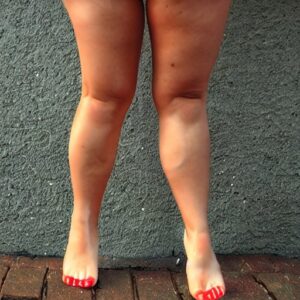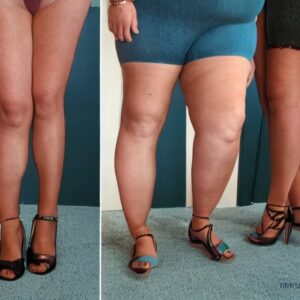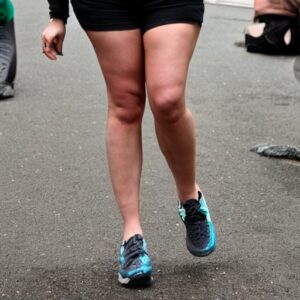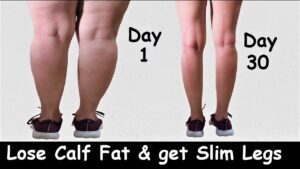 “Fat legs” is a term that is sometimes used to describe legs that appear larger or more voluminous due to excess body fat. This can be a subjective term, as what one person considers to be “fat legs” may not be the same as another person’s definition.
“Fat legs” is a term that is sometimes used to describe legs that appear larger or more voluminous due to excess body fat. This can be a subjective term, as what one person considers to be “fat legs” may not be the same as another person’s definition.
From a medical standpoint, having excess body fat can increase the risk of health issues such as high blood pressure, high cholesterol, type 2 diabetes, and cardiovascular disease. However, it’s also important to recognize that body fat distribution can vary from person to person, and genetics can play a role in where the body tends to store fat. Additionally, a person’s overall body composition, including muscle mass and bone density, can also affect the appearance of their legs.
If a person is concerned about the appearance of their legs, they may wish to speak with a healthcare provider or a qualified fitness professional for guidance on healthy lifestyle changes, such as exercise and nutrition, that can help them achieve their goals.
 Why do I have fat legs?
Why do I have fat legs?
There are a number of factors that can contribute to the development of fat legs. Some possible causes include:
Genetics: Your genes can play a significant role in determining your body shape and where you tend to store fat. Some people may be genetically predisposed to storing more fat in their legs.
Lack of physical activity: A sedentary lifestyle can contribute to the development of excess fat in the legs. Engaging in regular exercise can help to burn calories and promote weight loss.
Poor diet: Consuming a diet that is high in calories, sugar, and processed foods can contribute to the development of excess body fat, including in the legs.
Hormonal imbalances: Hormonal imbalances, such as those caused by polycystic ovary syndrome (PCOS) or thyroid disorders, can contribute to the development of excess body fat, including in the legs.
Fluid retention: In some cases, excess fluid retention can cause the legs to appear swollen and may contribute to the appearance of fat legs.
If you are concerned about the appearance of your legs, it’s important to approach the issue with a balanced perspective and consider healthy and sustainable approaches to weight loss, such as adopting a healthy diet and exercise routine. Consulting with a healthcare professional can be helpful in determining the underlying cause of fat legs and developing a safe and effective plan for improving overall health and well-being.
 How do I reduce my fat legs?
How do I reduce my fat legs?
Reducing fat in the legs is a gradual process that requires a combination of healthy diet, regular exercise, and lifestyle changes. Here are some tips that may help:
Engage in regular cardio exercise: Activities such as walking, running, cycling, or swimming can help burn calories and promote weight loss, including in the legs.
Incorporate strength training exercises: Strength training exercises such as lunges, squats, and leg presses can help to build muscle in the legs, which can help to increase calorie burn and promote weight loss.
Adopt a healthy, balanced diet: Eating a diet that is rich in whole, unprocessed foods such as fruits, vegetables, whole grains, and lean proteins can support overall weight loss, which may include fat loss in the legs.
Stay well hydrated: Drinking plenty of water can help to reduce fluid retention, which can contribute to the appearance of fat legs.
Manage stress: Chronic stress can cause the body to store excess fat, so finding healthy ways to manage stress, such as through meditation or yoga, can be helpful.
It’s important to remember that healthy weight loss is a gradual process that requires consistent effort and dedication. It’s always a good idea to speak with a healthcare professional or licensed aesthetician for guidance and support. They can help you develop a safe and effective plan for reducing fat in the legs, as well as provide advice on healthy diet and exercise habits that can support overall health and well-being.
 Exercise that can help reduce fat in the legs:
Exercise that can help reduce fat in the legs:
Deadlifts: Stand with your feet hip-width apart, bend your knees slightly and hinge at your hips, lowering your torso until it is parallel to the ground. Lift back up to starting position.
Side lunges: Step to the side with one leg, bending your knee and pushing your hips back. Return to starting position and repeat on the other side.
Inner thigh lifts: Lie on your side with your legs straight, lift your top leg a few inches off the ground and hold for a few seconds before lowering it back down.
Outer thigh lifts: Lie on your side with your legs straight, lift your top leg and bring it slightly behind your body, hold for a few seconds and then lower it back down.
Glute bridges: Lie on your back with your knees bent and feet flat on the ground, lift your hips up towards the ceiling, hold for a few seconds and then lower back down.
Squats: Squats are an excellent way to reduce fat in your legs. Stand with your feet shoulder-width apart, and slowly lower your hips as if sitting on a chair. Hold for a few seconds and then return to the starting position. Repeat for several sets.
Lunges: Lunges target your thighs, glutes, and calves. Step forward with one foot, and lower your body until your front knee is bent at a 90-degree angle. Hold for a few seconds, then push back to the starting position. Repeat for several sets on each leg.
Leg Press: Leg press is a gym equipment that is very effective for reducing fat in your legs. This machine targets your quads, hamstrings, and glutes.
Step-Ups: Step-ups target your quads, hamstrings, and glutes. Stand in front of a step or platform and step up with one foot, then bring your other foot up. Step back down and repeat for several sets on each leg.
Calf Raises: Calf raises are an excellent way to strengthen and tone your calves. Stand with your feet hip-width apart and raise onto the balls of your feet. Lower back down and repeat for several sets.
Jumping Jacks: Jumping jacks are a great way to get your heart rate up and burn calories. Stand with your feet together and jump out to the sides while raising your arms above your head. Jump back to the starting position and repeat for several sets.
Burpees: Burpees are a full-body workout that targets your legs, core, and upper body. Start in a standing position, drop down into a push-up position, jump your feet forward, and then jump up. Repeat for several sets.
Running: Running is an excellent way to burn calories and reduce fat in your legs. Start slowly and gradually increase your distance and speed.
Cycling: Cycling is another great way to burn calories and reduce fat in your legs. You can cycle outdoors or use a stationary bike at the gym.
Swimming: Swimming is a low-impact exercise that targets your legs, core, and upper body. You can swim laps, use a kickboard, or do water aerobics.
Remember to always start with a warm-up and stretch before beginning any exercise routine.